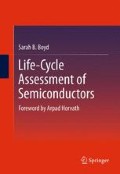Abstract
Determination of the life-cycle environmental and human health impacts of semiconductor logic is essential to a better understanding of the role information technology can play in achieving energy efficiency or global warming potential reduction goals. This chapter provides a life-cycle assessment for digital logic chips over 7 technology generations, spanning from 1995–2013. Environmental indicators include global warming potential, acidification, eutrophication, ground-level ozone (smog) formation, potential human cancer and non-cancer health effects, ecotoxicity and water use. While impacts per device area related to fabrication infrastructure and use-phase electricity and have increased steadily, those due to transportation and fabrication direct emissions have fallen as a result of changes in process technology, device and wafer sizes and yields over the generations. Electricity, particularly in the use phase, and direct emissions from fabrication are the most important contributors to life-cycle impacts. Despite the large quantities of water used in fabrication, water consumption is primarily driven by electricity generated for use-phase power. Reducing power consumption in the use phase is the most effective way to limit impacts, particularly for the more recent generations of logic.
Access this chapter
Tax calculation will be finalised at checkout
Purchases are for personal use only
References
Carnegie Mellon University Green Design Institute. Economic Input-Output Life Cycle Assessment (EIO-LCA), US 1997 Industry Benchmark model, Economic Input-Output Life Cycle Assessment (EIO-LCA), US 1997 Industry Benchmark model. http://www.eiolca.net, accessed May 15, 2009.
C. Cremer, W. Eichhammer, M. Friedewald, P. Georgieff, S. Rieth-Hoerst, B. Schlomann, P. Zoche, B. Aebischer, and A. Huser. Energy consumption of information and communication technology in Germany up to 2010. Technical report, 2003.
L. Deng and E. Williams. Measures and trends in energy use of semiconductor manufacturing. In International Symposium on Electronics and the Environment, Los Alamitos, CA, USA, 2008. IEEE.
EPA. The Emissions & Generation Resource Integrated Database for 2007 (eGrid2007), available online: www.epa.gov/cleanenergy/energy-resources/egrid/index.html. U.S. Environmental Protection Agency, September 2008.
EPA.The Emissions & Generation Resource Integrated Database for 2007 (eGrid2007) Technical Support Document. U.S. Environmental Protection Agency, September 2008.
V. Fthenakis and H. Kim. Greenhouse-gas emissions from solar electric and nuclear power: A life-cycle study. Energy Policy, 35:2549–2557, 2007.
Intel. Energy-Efficient Performance On The Client: A Proposed Measurement Methodology Version 2.0, available online http://www.intel.com/technology/eep/EEP_whitepaper.pdf. Intel Corporation, Santa Clara, CA, 2007.
IPCC. Climate Change 2007: The Physical Science Basis, Contribution of Working Group I to the Fourth Assessment Report of the Intergovernmental Panel on Climate Change. Cambridge University Press, Cambridge, UK and New York, NY, USA, 2007.
C. W. King and M. E. Webber. The water intensity of the Plugged-In automotive economy.Environmental Science & Technology, 42(12):4305–4311, June 2008.
N. Krishnan, S. Boyd, A. Somani, S. Raoux, D. Clark, and D. Dornfeld. A hybrid life cycle inventory of nano-scale semiconductor manufacturing.Environmental Science and Technology, 42(8):3069–3075, Apr. 2008.
N. Krishnan, S. Thurwachter, T. Francis, and P. Sheng. The environmental value systems (EnV-S) analysis: Application to CMP effluent treatment options. In Proceedings of the Electrochemical Society (ECS) Conference on Improving Environmental Performance of Wafer Manufacturing Processes. ECS, 2000.
C. F. Murphy, G. A. Kenig, D. T. Allen, J.-P. Laurent, and D. E. Dyer. Development of parametric material, energy and emission inventories for wafer fabrication in the semiconductor industry.Environmental Science and Technology, 37(23):5373–5382, 2003.
M. O’Halloran. Fab Utility Cost Values for Cost of Ownership (CoO) Calculations, Technology Transfer #02034260A-TR, available online: www.sematech.org/docubase/abstracts/4260atr.htm. Technical Report 02034260A-TR, International Sematech, 2002.
S. Pacca and A. Horvath. Greenhouse gas emissions from building and operating electric power plants in the Upper Colorado River Basin. Environmental Science and Technology, 36(14):3194–3200, June 2002.
T. W. Peterson. VOC emissions reduction from photolithographic processes, available online: http://www.erc.arizona.edu/. Technical report, University of Arizona, 1999.
S. M. Pieper, J. M. Paul, and M. J. Schulte. A new era of performance evaluation.Computer, 40(9):23–30, 2007.
A. Plepys. The grey side of ICT.Environmental Impact Assessment Review, 22:509–523, 2002.
A. Plepys.Environmental Implications of Product Servicising: The Case of Outsourced Computing Utilities. PhD Thesis, Lund University, Sept. 2004.
Sematech. The international technology roadmap for semiconductors: 2009, 2007, 2005, 2003, 2001, 1999 editions and 2010, 2008 and 2006 updates. Technical report, 1999–2010.
J. M. Sherer. Semiconductor industry wafer fab exhaust management. CRC Press, 2005.
J. M. Sherer and J. W. Swauger. High removal efficiency water scrubbers for low inlet acid compound concentrations in the semiconductor industry, October 1998.
M. Tekwawa, S. Miyamoto, and A. Inaba. Life cycle assessment; an approach to environmentally friendly PCs. In Proceedings of the IEEE International Symposium on Electronics and the Environment, pages 125–130, 1997.
E. D. Williams, R. U. Ayres, and M. Heller. The 1.7 kilogram microchip: Energy and material use in the production of semiconductor devices.Environmental Science and Technology, 36(24):5504–5510, 2002.
Author information
Authors and Affiliations
Corresponding author
Rights and permissions
Copyright information
© 2012 Springer Science+Business Media, LLC
About this chapter
Cite this chapter
Boyd, S.B. (2012). Life-Cycle Assessment of CMOS Logic. In: Life-Cycle Assessment of Semiconductors. Springer, New York, NY. https://doi.org/10.1007/978-1-4419-9988-7_5
Download citation
DOI: https://doi.org/10.1007/978-1-4419-9988-7_5
Published:
Publisher Name: Springer, New York, NY
Print ISBN: 978-1-4419-9987-0
Online ISBN: 978-1-4419-9988-7
eBook Packages: EngineeringEngineering (R0)

